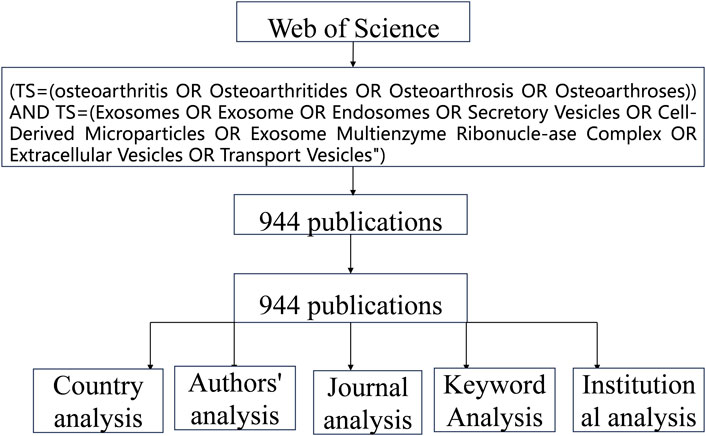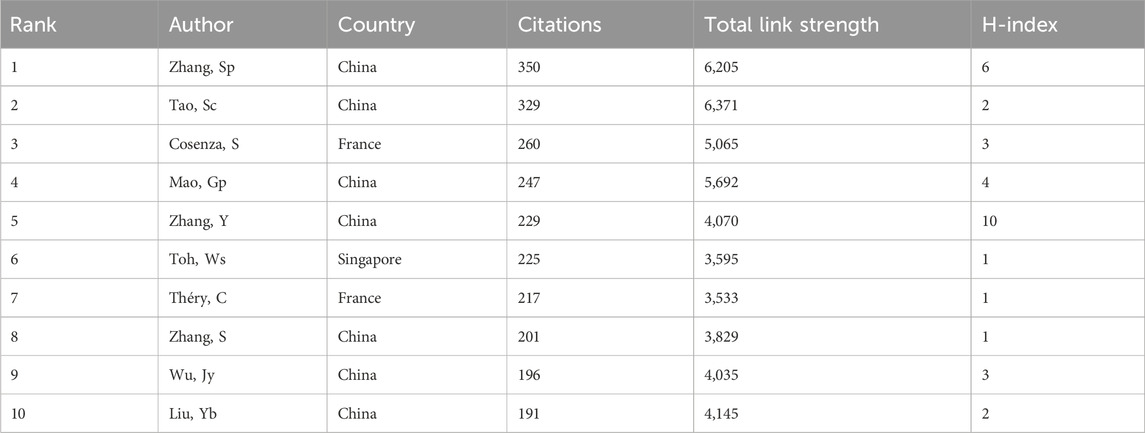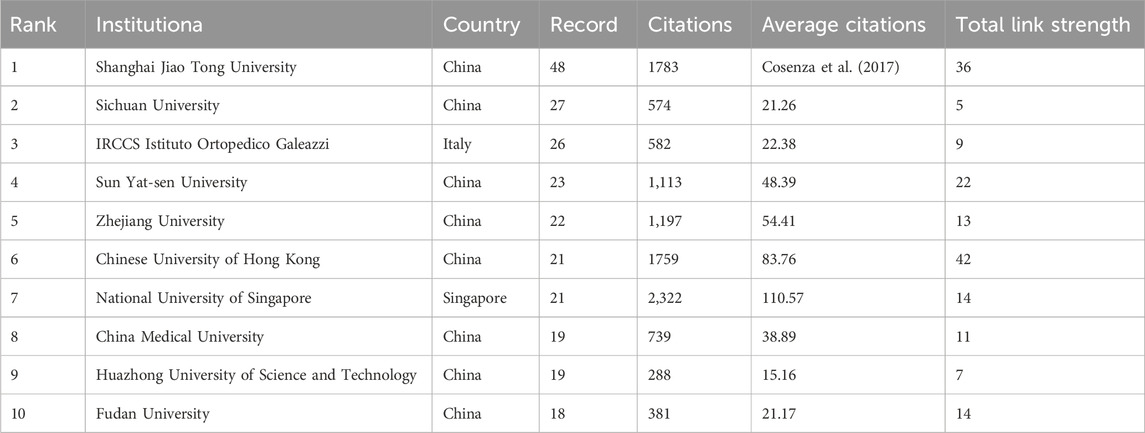- 1The Fourth Clinical College of Xinjiang Medical University, Urumqi, China
- 2Department of Orthopaedic, Institute of Traditional Chinese Medicine Hospital of Xinjiang Uygur Autonomous Region, Urumqi, China
- 3Department of Orthopaedic, Xinjiang Uygur Autonomous Region Institute of Traditional Chinese Medicine, Urumqi, China
- 4Department of orthopaedic, The Fourth Affiliated Hospital of Xinjiang Medical University, Urumqi, China
Background: Degenerative joint disease, known as osteoarthritis (OA), is characterized by pain, swelling, and decreased mobility. The illness has a major negative influence on patients’ quality of life and is common around the world, especially among older people. Nevertheless, there are insufficient possibilities for early diagnosis and therapy. Extracellular vesicles, or EVs, control the immune response, tissue healing, and cellular communication.
Methods: This work offers a bibliometric representation of the areas of focus and correlations between extracellular vesicles and osteoarthritis. We searched for osteoarthritis and extracellular vesicles in publications in the Web of Science Core Collection (WoSCC) database. Bibliometrics, an R package, CiteSpace 6.1. R2, and VOSviewer 1.6.17 were used to perform bibliometric analyses of concentration fields, trends, and relevant factors.
Results: 944 papers from 59 nations were published; the countries that contributed the most to the field were China, the USA, and Italy. Professors Laura and Enrico are the top contributors. Sichuan University, Istituto Ortopedico Galeazzi, and Shanghai Jiao Tong University are the top three universities. The International Journal of Molecular Sciences is an excellent publication. Exosome, expression, knee osteoarthritis, extracellular vesicle, mesenchymal stem cell, osteoarthritis, and inflammation are the most often occurring keywords.
Conclusion: These results suggest areas of interest and focus for future research on EVs and OA. This trend suggests that the volume of literature on OA and EVs will continue to rise, with more research being published in the future. This study helps scholars understand current research hotspots in the field and may inspire future research.
1 Introduction
Osteoarthritis OA is a degenerative disease of the bones and joints that can be recognized by inflammation of the synovium, secondary osteophytes, and loss of articular cartilage. The most common clinical manifestations include stiffness, discomfort, edema, and dysfunction (Hunter, 2015; Sharma, 2021). With an approximate global burden of 16%, the prevalence of OA has dramatically increased due to the growing number of elderly and obese people (Cui et al., 2020). In China, the prevalence of OA exceeds 50% in people with knee pain over the age of 65, and the prevalence of OA exceeds 80% in those over the age of 75 with knee pain (Tang et al., 2016).
OA has a long disease progression period and is strongly associated with older age, gender, overweight, residential environment, and genetic predisposition (Di et al., 2024; Georgiev and Angelov, 2019; Simão et al., 2019). It also has a lengthy progression time. OA may result in decreased quality of life, disability, loss of joint function, and higher medical costs for patients (Ali et al., 2017). Patients with KOA are often assessed using the Kellgren-Lawrence (K-L) classification. Total knee arthroplasty (TKA) and unicompartmental knee arthroplasty (UKA) are frequently utilized for patients with grade III or IV K-L classification (Mancuso et al., 2016; Yao et al., 2023; Zhao et al., 2022).
However, there are issues related to high surgical costs, infections, blood embolism, implant lifespan, and longevity (Gililland et al., 2012; Sloan and Lee, 2021). Patients with early OA, such as those classified as grade I or II in the K-L grading system, are frequently treated with PRP (platelet-rich plasma), sodium hyaluronate, and non-steroidal anti-inflammatory medicines (NSAIDs) (Feng et al., 2023; Sánchez et al., 2021; Su et al., 2018). However, most of these treatments only moderate its symptoms of OA and do not fundamentally reverse its pathological changes. Therefore, exploring treatment modalities for OA is a worthwhile topic for in-depth investigation.
Stem cell therapy has become available as an experimental and clinical treatment option for adolescent OA. However, there are risks, such as safety and potential tumour differentiation (Damjanov and Andrews, 2016). EVs, a type of cell-free therapy, have been extensively studied for their advantages in regeneration, immunomodulation, and inflammation modulation by researchers (Liu et al., 2023; Lv et al., 2020). EVs are membrane structures that frequently originate from cells and have a diameter that ranges from 100 nm to 1 µm. Initially thought to be primarily metabolic waste products by researchers, EVs now represent a broad category of substances (Vandergriff et al., 2018; Andaloussi et al., 2013). All prokaryotic and eukaryotic cells studied to date produce and release phospholipid bilayer biovesicles known as EVs, containing abundant lipids, protein, ribonucleic acid, and other physiologically active substances. EVs are typically classified based on their vesicle diameter into apoptotic bodies, microvesicles, microparticles (Bheri et al., 2020; Andaloussi et al., 2013), and nano-vesicles (Zhang et al., 2021; Pang et al., 2023).
Apoptotic bodies are vesicles released by apoptotic cells containing intracellular proteins and nucleic acids (Xu et al., 2019). Microvesicles are small membranous vesicles secreted by microorganisms, containing proteins and lipids from the microorganism’s surface (Wang X. et al., 2022). Small vesicles with membranes called microvesicles can get into cells and deliver lipids, proteins, and genetic information (Xie et al., 2016). EVs have shown promising results in treating conditions such as myocardial infarction (Nian and Fu, 2023), spinal cord injury (Fan et al., 2022), tumors (Shao et al., 2022), diabetes (Sun et al., 2021), and others in previous studies.
Bibliometrics is an essential tool for research assessment, systematically analyzing literature to provide researchers with comprehensive insights into data and trends (Zhang et al., 2023a; Zhang et al., 2023b). It provides a comprehensive overview of research trends, hotspots, and developmental behaviors within a particular field or matter. Bibliometrics helps assess the quantity and quality of publications on current topics, institutions, and regions. It also forecasts future research directions and guides research trends (Zhou et al., 2023; Hu et al., 2023). While studies on EVs and OA are present in existing bibliographic analyses, fewer studies have focused on bibliometric analyses specifically.
Using the WoSCC database, bibliometric tools like CiteSpace and VOSviewer, and websites like bibliometric.com, this study provides a bibliometric analysis of documents about EVs and OA. The analysis covers aspects such as country, institution, authors, journals, highly cited publications, and keywords. The study sheds light on hotspots, research trends, and upcoming advancements in EVs and OA.
2 Materials and methods
2.1 Data collection
This study employed the Web of Science Core Collection (WoSCC), a globally indexed scientific database. To ensure data accuracy, searches were conducted, data downloaded, and data analysis performed on 1 January 2025. The search covered publications from 1 January 2000 to 31 December 2024, with the following Boolean query: TS=(Osteoarthritis OR Osteoarthritides OR Osteoarthrosis OR Osteoarthroses) AND TS=(Exosomes OR Extracellular Vesicles OR Secretory Vesicles OR Cell-Derived Microparticles). The search adhered strictly to the predefined keywords, and retrieved records underwent systematic analysis. Full-record datasets, including abstracts and citations, were exported and processed as outlined in Figure 1 (data extraction workflow).
3 Results
3.1 Trend analysis of publications
By conducting a keyword-based search in the Web of Science Core Collection (WoSCC) database, a total of 944 research articles related to extracellular vesicles (EVs) and osteoarthritis (OA) were identified. The first study exploring the relationship between EVs and OA dates back to 2000. From 2000 to 2015, the number of publications in this field remained relatively low (as shown in Figure 2), indicating limited academic attention during this period. Starting in 2016, the annual number of publications surpassed double digits for the first time, with 12 papers published that year.
Between 2016 and 2019, the number of publications continued to grow, reflecting a significant increase in research output. In 2021, the number of publications exceeded 100 (reaching 147), and by 2024, it peaked at 210. Although there was a slight decline in the number of publications in 2023 compared to 2022, the overall trend remained highly productive. As illustrated in Figure 2, research on EVs in OA has shown a consistent upward trajectory over the past 5 years, gradually emerging as an important and rapidly growing field. This trend is further supported by the increasing proportion of original research articles compared to review articles, highlighting the growing focus on the therapeutic, diagnostic, and mechanistic roles of EVs in OA. The substantial and valuable research output in this field underscores its potential for further exploration and development.
3.2 Countries/regions analysis
A visual analysis of the 944 publications from 2000 to 2024, focusing on the countries and regions involved, was conducted using VOSviewer software. When the threshold was set to one publication, 59 countries met this criterion; when the threshold was increased to four publications, 32 countries qualified.
As shown in Figure 3A, five clusters were identified, with the largest cluster comprising China and the United States. This cluster includes China, the United States, Japan, and Australia, encompassing 683 articles, which account for 72.35% of the total publications (Table 1). China leads with 518 articles, representing 54.87% of the total, and has garnered 15,077 citations, with an average of 29.11 citations per article and an H-index of 52. The total link strength of 82 highlights China’s prominent position in this research field and its extensive international collaborations, as illustrated in Figures 3B, C.
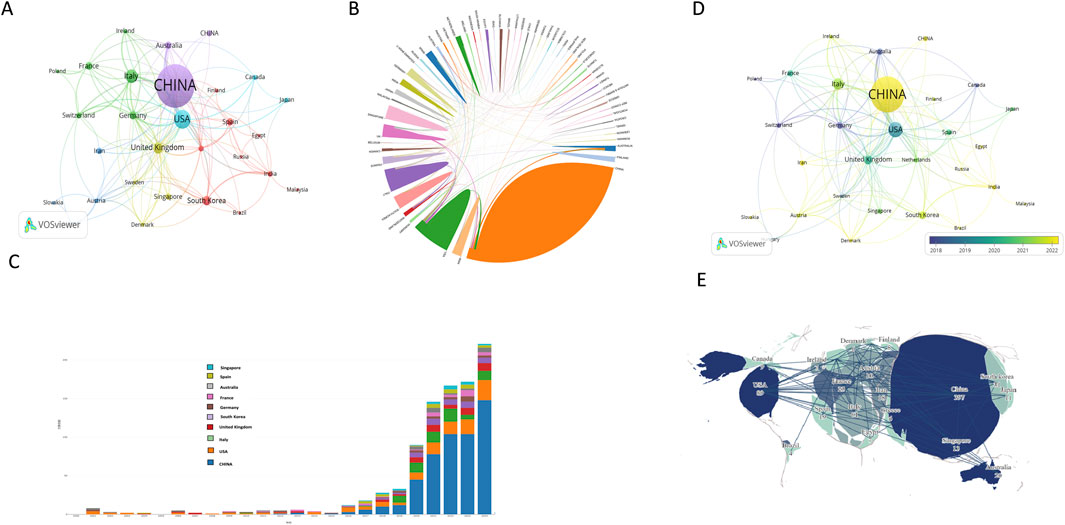
Figure 3. National collaborative analysis of extracellular vesicles and osteoarthritis (A) Collaboration between countries or regions based on VOSviewer; (B) The coauthorship network map of countries; (C) Annual number of publications in different countries (D) Map of the network of countries working together in time; (E) The coauthorship network map of countries.
The United States ranks second with 124 articles, accounting for 13.14% of the total. Its H-index is 30, and its publications have received 5,838 citations, with an average of 47.08 citations per article. Although the United States has fewer publications and a lower H-index compared to China, its higher average citation count reflects the broader recognition and impact of its research. Among the top ten countries, Germany stands out with 27 articles and the highest average citation count (62.84 per article), indicating the high quality and recognition of its research in this field.
Since 2017, China’s research output has grown consistently, particularly after 2020, when its annual publications accounted for more than half of the total in this field. Both China and the United States serve as key nodes connecting other countries, driving significant advancements and collaborations in the field (Figures 3D, E). Over the past 3 years, China has been the most active country in terms of research and publications, demonstrating strong support and keen interest from scholars in this area.
3.3 Authors and co-cited authors analysis
A visual analysis of the authors included in the publications was conducted using VOSviewer software. When the publication threshold was set to one, 5,166 authors were identified as contributing to this research field; when the threshold was increased to five, 75 authors met this criterion. As shown in Figure 4A, the authors were grouped into distinct clusters based on their research areas and affiliated institutions.
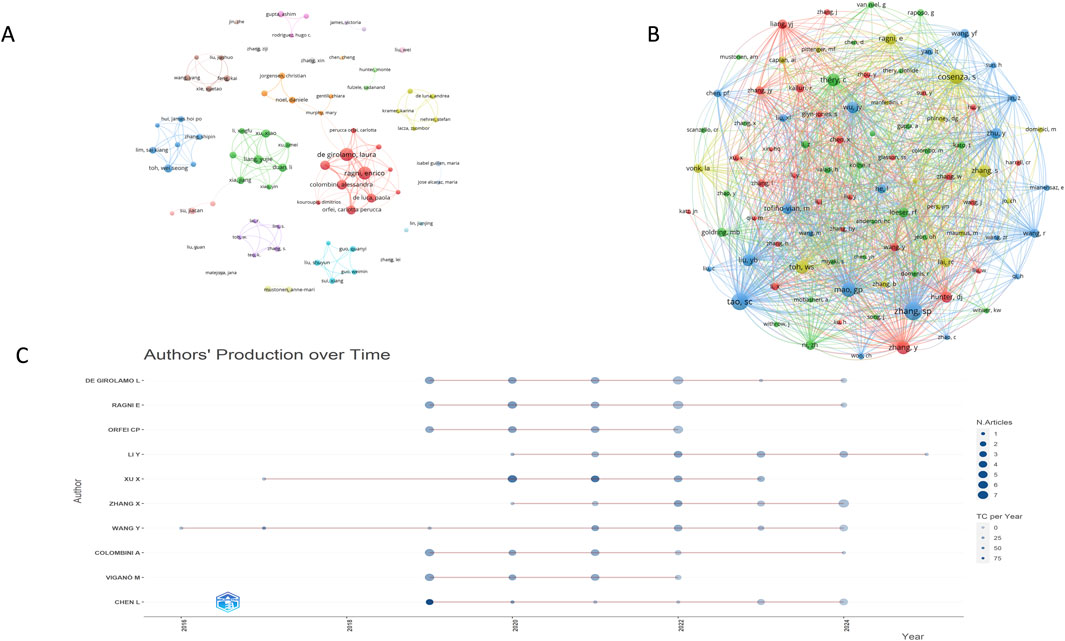
Figure 4. Analysis of author collaboration on extracellular vesicles and osteoarthritis. (A) Collaboration between authors based on VOSviewer; (B) Author co-citation coupling map; (C) Annual volumeof publications by top 10 authors.
The largest cluster comprises nine authors, primarily including Professor Laura de Girolamo and Professor Alessandra Colombini from Italy. The second-largest cluster consists of Professor Li Duan, Professor Li Xingfu, Professor Liang Yujie, Professor Wang Daping, Professor Xia Jiang, Professor Xiao Yin, Professor Xu Limei, and Professor Xu Xiao from Shenzhen University in China. Notably, these authors exhibit strong collaborative ties, making significant contributions to the advancement of the field (Figure 4A). Based on publication counts, Professor Laura de Girolamo and Professor Enrico Ragni from IRCCS Istituto Ortopedico Galeazzi in Italy have the highest number of publications, with 23 each (Table 2). It is worth noting that the top five authors by publication volume are all from Italy, highlighting the high level of collaboration and productivity among Italian scholars in this field. Chinese scholars Professor Liang Yujie and Professor Li Duan rank sixth. Professor SP Zhang from Singapore and Professor Tao SC from China are the most co-cited authors, with 350 and 329 co-citations, respectively (Table 3). In Figure 4B, the node size represents the co-citation count, and the line thickness indicates the co-citation strength between cited references. This visualization underscores the high recognition of authors such as Zhang SP, Tao SC, Alessandra Colombini, and Marco Viganò, reflecting the quality and academic impact of their work.
Among the top ten authors by publication volume, Professor Xu Xiao from Shenzhen University leads with an average of 130.58 citations per article, followed by Professor Toh Wei Seong and Professor De Luca Paola, with 63.75 and 61.33 citations per article, respectively. Figure 4C shows that most of these leading authors began their research around 2019, a year that marked a significant increase in the volume of publications in this field. This growth has continued through 2024, indicating that the field still holds substantial untapped potential.
3.4 Analysis of institution and research areas
A visual analysis of institutions involved in the included literature was conducted using VOSviewer software. When the publication threshold was set at 1, 1,214 institutions were identified as active in this research field, while increasing the threshold to five reduced the number to 97 qualifying institutions. Figure 5A demonstrates distinct clustering patterns formed by authors from different research fields and institutions. These 76 institutions were organized into 5 clusters, with prominent representation from Chinese and American institutions in the larger clusters. Notably, institutions such as Zhejiang University, Sichuan University, Shanghai Jiao Tong University, and Shenzhen University demonstrated significant contributions (Figures 5A, B).
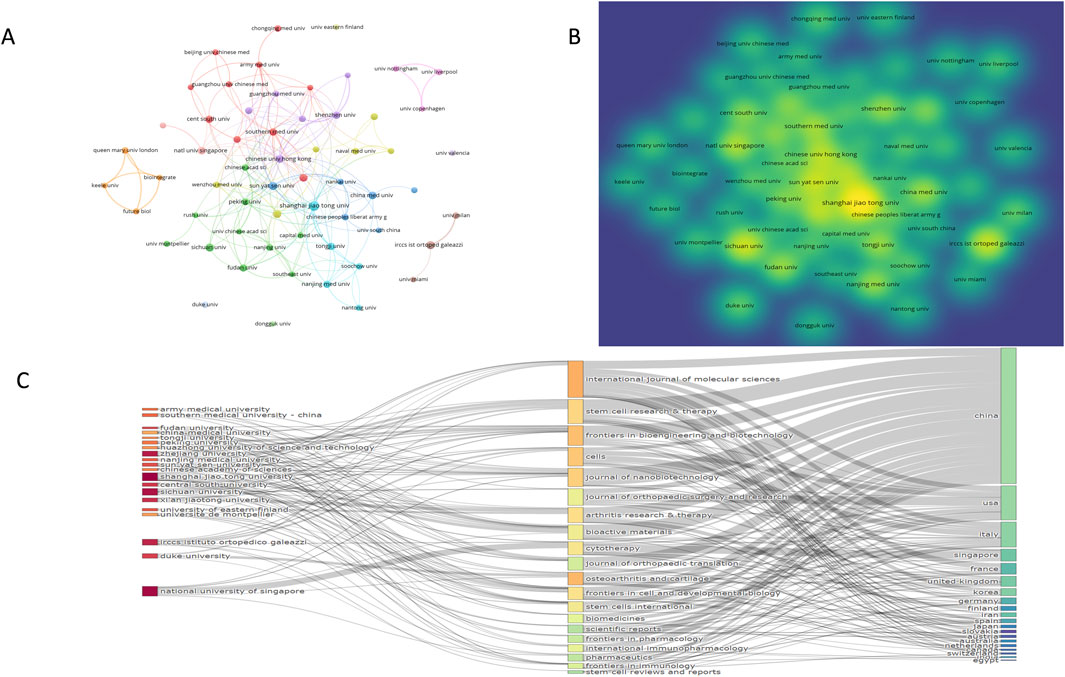
Figure 5. Analysis of institutional cooperation between extracellular vesicles and osteoarthritis (A) Collaboration between institution based on VOSviewer; (B) Hot spot distribution map of institutional issues; (C) Three plot map of institutions-journals-countries.
As shown in Table 4, Shanghai Jiao Tong University leads with 48 publications (5.08% of total publications), receiving 1,783 citations (37.15 citations per article). This is followed by Italy’s Sichuan University with 27 publications (2.86% of total), receiving 574 citations (21.26 per article), and subsequently IRCCS Istituto Ortopedico with 26 publications (2.75% of total) and 582 citations (22.38 per article). Both Figure 5C and Table 4 reveal that Chinese institutions occupy 8 of the top 10 positions by publication volume. This highlights China’s substantial engagement and contributions in this field, reflecting its growing recognition and institutional support within the research community.
3.5 Analysis of journals and research areas
A visual analysis of journals in this field from 2000 to 2024 was conducted using VOSviewer software. When the publication threshold was set to one, 315 journals were identified as contributing to this research area; when the threshold was increased to five, 49 journals met this criterion. Figures 6A, B reveal that Frontiers in Bioengineering and Biotechnology, International Journal of Molecular Sciences, Cells, and Stem Cell Research & Therapy form the largest clusters, indicating their prominent role and high activity in publishing articles within this field. As shown in Table 5, the International Journal of Molecular Sciences leads with 51 articles, accumulating 757 citations and an average of 14.84 citations per article, alongside a 2024 impact factor of 3.7. Notably, the Stem Cell Research & Therapy published 23 articles, which received 2,050 citations with an average of 89.13 citations per article, demonstrating the highest average citation rate in this research domain. Figure 6C illustrates that publication numbers were relatively low between 2000 and 2014, but a marked increase began in 2019 and continued to rise through 2024. Most top-ten journals reached their peak in 2022 followed by a slight decline, with 2020–2024 representing the most prolific period.
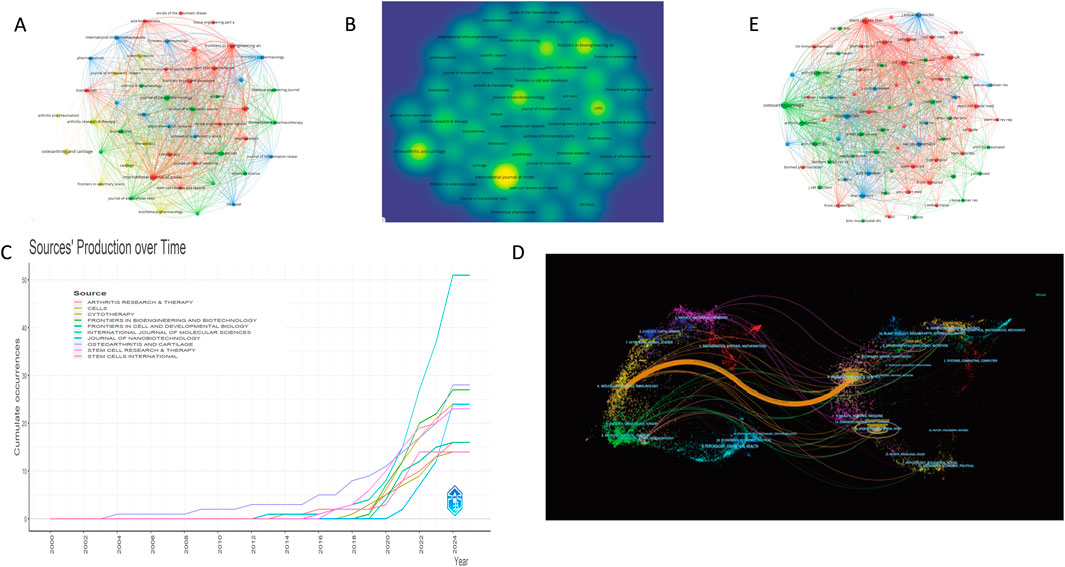
Figure 6. Journal collaboration analysis of extracellular vesicles and osteoarthritis. (A) Collaboration between journal based on VOSviewer. (B) Hot spot distribution map of journal issues; (C) Top 10 journals in terms of annual number of publications. (D) The dual-map overlay of journals contributed to publications. (E) Journal co-citation collaboration network mapping.
As shown in Figure 6D, the most frequently co-cited journals in bibliographic coupling analysis include International Journal of Molecular Sciences, Stem Cell Research & Therapy, Biomaterials, and Osteoarthritis and Cartilage. These journals have exerted significant influence on research and publications in this field, not only in terms of publication volume and co-citation frequency but also as critical channels for advancing scholarly discourse. Figure 6E presents a dual-map overlay of articles published between 2000 and 2024. Citation relationships are represented by colored lines on the right side (citing journals) and cited journals on the left. The analysis reveals a concentration of research in publications related to physics, materials science, chemistry, immunology, molecular biology, medicine, and clinical studies. Most cited journals originate from disciplines such as sports science, rehabilitation, materials science, chemistry, genetics, molecular biology, and physics. The interdisciplinary networks and collaborations reflect current developments and emerging areas of interest across these domains.
3.6 Analysis of references
As shown in Figures 7A, B, the studies were collectively analyzed based on their citations. Using VOSviewer, publications with ≥100 citations were analyzed, revealing the top-cited works. The leading study, “Implant-Derived Magnesium Induces Local Neuronal CGRP Production to Promote Fracture Healing in Rats” (Zhang Y. et al., 2016). Published in Nature Medicine, has accumulated 622 citations (an average of 77.75 citations per year). This groundbreaking research demonstrates that magnesium ions enhance calcitonin gene-related peptide (CGRP)-mediated osteogenic differentiation by activating the MAGT1-dependent transient receptor potential cation channel, Table 6.
Ranking second is “Mesenchymal Stem Cell-Derived Exosomes Mediate Cartilage Repair by Enhancing Proliferation, Inhibiting Apoptosis, and Modulating Immune Responses” (Zhang et al., 2018), with 568 citations (an average of 94.67 citations per year). This study highlights the molecular mechanism by which exosomal CD73 promotes cell proliferation and infiltration during cartilage regeneration through the activation of the AKT and ERK signaling pathways. Notably, it was the first to reveal that inhibiting this pathway does not affect matrix synthesis but significantly reduces cell migration and proliferation. In third place is “Exosomes Derived from miR-140-5p-Overexpressing Synovial Mesenchymal Stem Cells Enhance Cartilage Regeneration and Prevent Osteoarthritis in Rat Knees” (Tao et al., 2017), published in Theranostics, with 475 citations (an average of 67.86 citations per year). This study systematically demonstrates that SMSC-140-Exos simultaneously promote the migration, proliferation, and extracellular matrix (ECM) secretion of articular chondrocytes (ACs) in vitro, while also validating their therapeutic potential in preventing osteoarthritis (OA) in a rat model. The academic influence of these highly cited studies underscores their significant value in advancing the field.
3.7 Analysis of Keywords
Keyword analysis is a critical tool for identifying the research focus of publications. Keywords appearing ≥100 times include extracellular vesicle (302 times), mesenchymal stem cell (253 times), osteoarthritis (179 times), exosomes (165 times), expression (113 times), knee osteoarthritis (106 times), and inflammation (104 times). Table 7 lists the top 20 keyword frequencies related to extracellular vesicles (EVs) in arthritis. In Figure 8A, larger squares represent higher keyword frequencies, while smaller squares indicate lower frequencies.
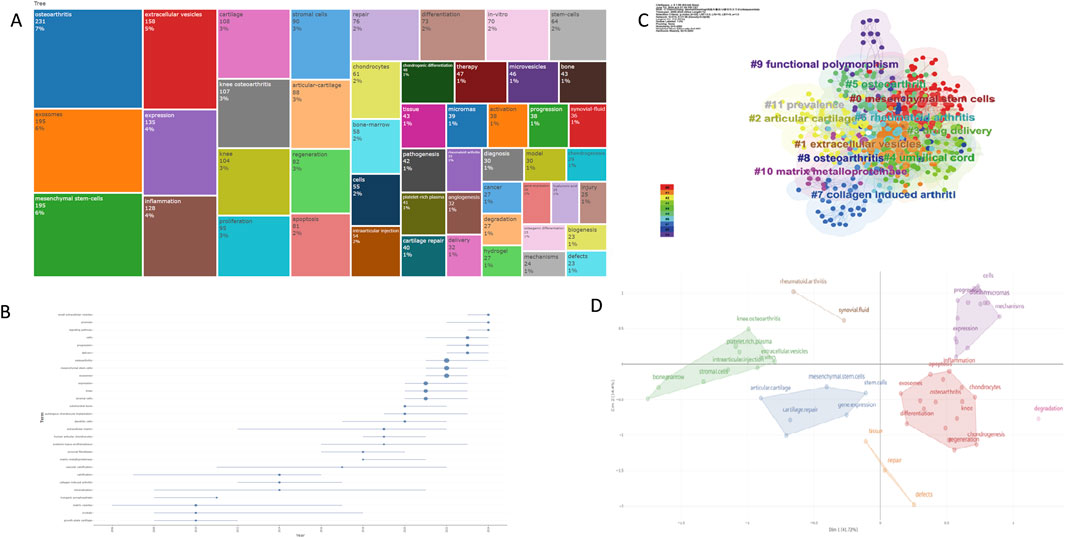
Figure 8. Keyword analysis of extracellular vesicles and osteoarthritis (A) Keyword Frequency Map (B) Keyword trend (C) and (D) Keywords clustering influencing factors analysis map and keyword clustering.
These keywords were organized into 10 clusters: #0 mesenchymal stem cells, #1 extracellular vesicles, #2 articular cartilage, #3 drug delivery, #4 umbilical cord, #5 osteoarthritis, #6 rheumatoid arthritis, #7 collagen-induced arthritis, #8 functional polymorphism, and #9 matrix metalloproteinase. These clusters encapsulate the research hotspots and focal areas of EVs in arthritis, as illustrated in Figures 8B–D. The thematic grouping of keywords further enhances the clarity and organization of research priorities in the study of EVs in osteoarthritis (OA).
4 Discussion
4.1 General information
From 2000 to 2024, the period from 2016 to 2024 marked a phase of rapid development in this field, with a significant increase in the number of publications. During this dynamic decade, researchers from China and the United States made substantial contributions to the field. China ranked first with 518 publications, 15,077 citations, an average of 29.11 citations per publication, and an H-index of 52. The United States ranked second with 124 publications, 5,838 citations, an average of 47.08 citations per publication, and an H-index of 30. Italy ranked third with 73 publications, an H-index of 23, and 1,741 citations (averaging 23.85 citations per publication). These countries demonstrated strong collaborative relationships and collectively advanced the development of this research field.
Professors De Girolamo, Laura and Ragni, Enrico each published 23 articles, ranking first with H-indices of 13 and average citation rates of 21.74 and 37.15 per article, respectively. Between 2020 and 2022, the top ten authors exhibited significant publication output, averaging at least three articles per year (Figure 4). In the institutional analysis, Shanghai Jiao Tong University led with 48 publications, an average of 37.5 citations per article, and a total link strength of 36. Sichuan University ranked second with 27 publications, an average of 21.26 citations per article, and a total link strength of 5. IRCCS Istituto Ortopedico Galeazzi ranked third, with 26 publications, an average of 22.38 citations per article, and a total link strength of 9.
These institutions, including Zhejiang University and Shenzhen University (SZU), exhibit close collaboration and have driven significant advancements in the field (Figure 5). In the journal analysis, Frontiers in Bioengineering and Biotechnology, International Journal of Molecular Sciences, Cells, and Stem Cell Research & Therapy rank as the top four journals, each publishing over 20 articles, reflecting their strong engagement and high publication frequency in this domain. A distinct clustering phenomenon is observed among these journals, with the largest cluster highlighted in red in the visualization.
4.2 Hotspots and trends
Cluster analysis in keyword analysis effectively summarizes research hotspots and trends. Key terms such as #0 mesenchymal stem cells and #1 extracellular vesicles are pivotal in extracellular vesicle (EV) research. These EVs are categorized into non-plant-derived and plant-derived EVs based on their origins, reflecting the diversity and scope of research in this field (Lv et al., 2020; Qiu et al., 2023).
4.3 Relationship between non-plant-derived EVs and OA
Non-plant-derived EVs and plant-derived EVs, have garnered significant research interest for their therapeutic potential in OA. Bone marrow mesenchymal stem cell (BMSC)-derived EVs are among the earliest and most extensively studied strategies, demonstrating efficacy in chondrocyte proliferation, anabolism, and apoptosis inhibition, Figure 9 (Pittenger et al., 1999).
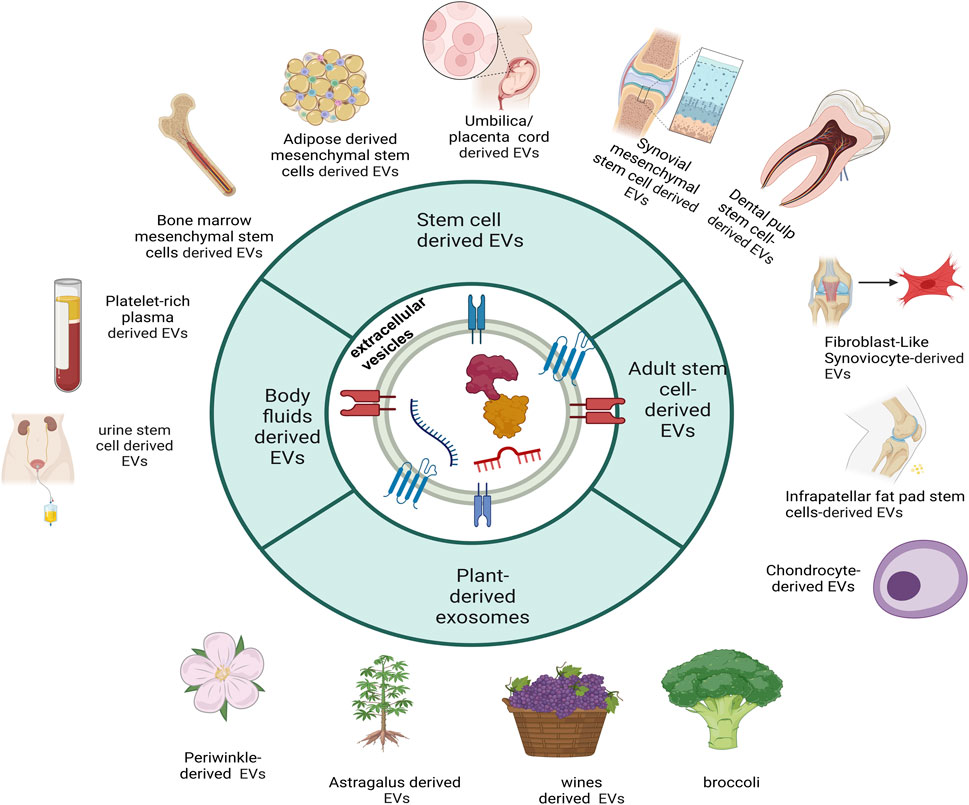
Figure 9. Evs from different sources play different roles in the treatment of OA (Chen et al., 2022; Yıldırım et al., 2024; Sarasati et al., 2023; Liu et al., 2024; Wang et al., 2021; Zhou et al., 2022; Sánchez et al., 2021; Meng et al., 2023; Kim et al., 2016; Gupta et al., 2021).
Exosomes from BMSCs treated with decellularized extracellular matrix (dECM-BMSC-Exos) enhance cartilage repair via miR-3473b-mediated PTEN/AKT pathway activation (Zhang B. et al., 2023). In monosodium iodoacetate (MIA)-induced OA models, BMSC-derived exosomes upregulate collagen II and MMP13 expression (He et al., 2020), while TUC339-enriched exosomes promote macrophage polarization to the anti-inflammatory M2 phenotype, mitigating joint injury (Shen et al., 2023). BMSCs further regulate immunomodulation through autotaxin-YAP pathway modulation (Wang et al., 2021). Dental pulp stem cells (DPSCs), sharing surface marker similarities with BMSCs but exhibiting superior proliferative capacity, enhance chondrocyte repair via intra-articular exosome delivery. These exosomes suppress TRPV4-mediated osteoclast activity, reducing subchondral bone remodeling and cartilage degradation in murine OA models (Fu et al., 2023). Adipose-derived stem cells (ADSCs), prized for their abundance and accessibility, secrete exosomes (ADSC-Exos) that promote cartilage regeneration and reduce inflammation. Elastogen (TE) pretreatment amplifies ADSC-Exo secretion and upregulates miR-451-5p, enhancing chondrocyte matrix synthesis and repair in anterior cruciate ligament transection (ACLT) models (Meng et al., 2023).
Clinical translation efforts include chemically defined medium (CDM)-cultured small EVs (CDM4-sEVs), which exhibit high purity and stimulate chondrocyte proliferation, migration, and differentiation. CDM4-sEVs inhibit osteochondral degeneration in vivo, underscoring their therapeutic potential (Hanai et al., 2023). Synovial MSC-derived exosomes (SMSC-Exos) drive chondrocyte migration and collagen synthesis via Wnt5a/5b-YAP signaling, albeit at the expense of SOX9-dependent extracellular matrix production (Park et al., 2015; Liu and Lefebvre, 2015). SMSC-Exos also mitigate IL-1β-induced cartilage degradation through NRP1 targeting and miR-485-3p-mediated PI3K/Akt suppression (Qiu et al., 2024). Umbilical cord-derived MSC exosomes (hucMSC-EVs), aligned with keyword cluster #4 (“umbilical cord”), demonstrate chondroprotective effects by enhancing COL2A1 and aggrecan expression while suppressing ADAMTS5 and MMP13. METTL3-mediated NLRP3 m6A methylation reduction underlies their anti-inflammatory action (Zhou et al., 2022; Jin et al., 2021).
Exosomes that overexpress miR-92a-3p in MSCs promote matrix gene expression and cartilage growth. On the other hand, exosomes that block miR-92a-3p decrease chondrogenic differentiation and upregulate WNT5A expression, which reduces the formation of cartilage matrix. WNT5A is the direct target of miR-92a-3p, which inhibits its activity. Exosomes overexpressing miR-92a-3p could potentially serve as inhibitors of the Wnt signalling pathway and may be developed as therapeutic agents to modify the disease process in OA (Mao et al., 2018). However, more investigation is required to clarify the underlying mechanisms in more depth. Perinatal stem cells, including embryonic MSCs (EMSCs) and amniotic membrane MSCs (hAMSCs), balance extracellular matrix synthesis and degradation. EMSC-EVs preserve chondrocyte phenotype under inflammatory conditions (Wang et al., 2017), while hAMSCs outperform ADSCs in modulating synovial macrophage polarization and glycosaminoglycan preservation (Topoluk et al., 2018).
Amniotic fluid stem cell exosomes (AFSC-Exos) deliver immunomodulatory factors (e.g., TGF, HGF) to attenuate inflammation and fibrosis (Beretti et al., 2018). hUSC-140-Exos further promote cartilage regeneration via VEGFA signaling (Liu et al., 2022). Collectively, these findings highlight MSC-EVs as versatile tools for OA intervention, though deeper mechanistic insights are needed to optimize clinical applications (Figures 9, 10) (Cheng et al., 2023; Yu et al., 2022; Kim et al., 2020; Wang S. et al., 2022).
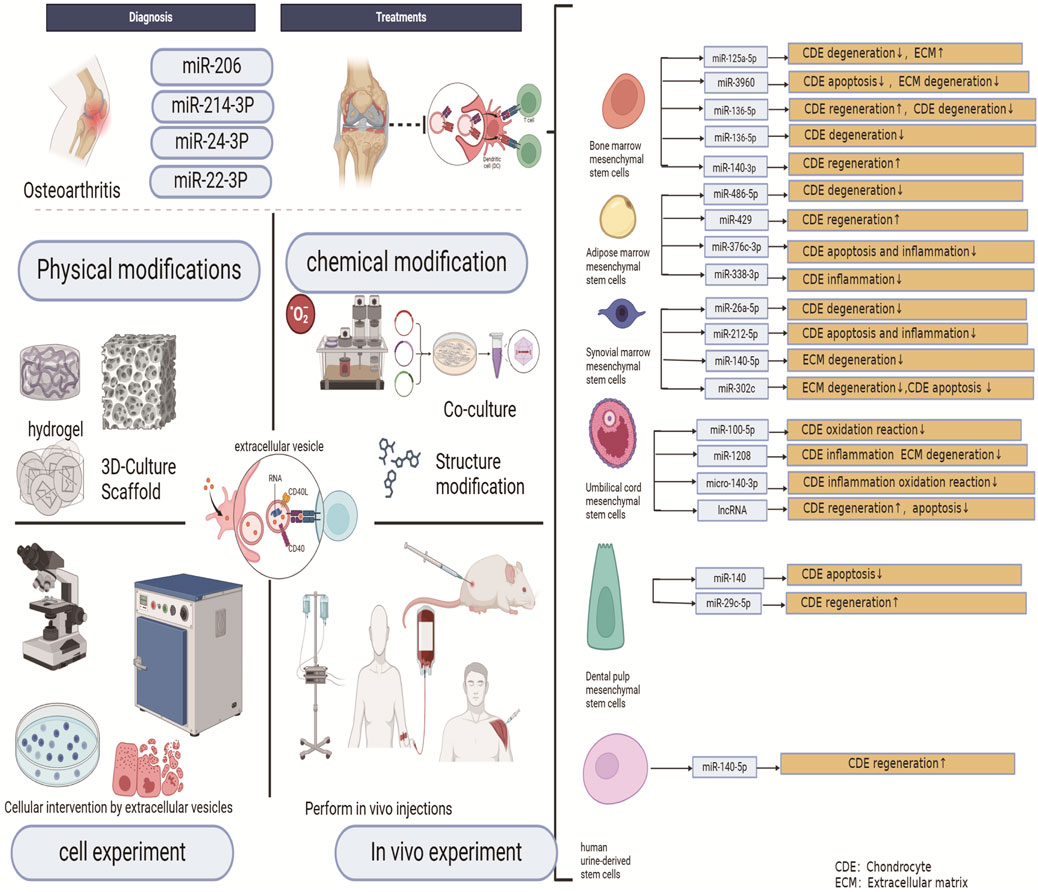
Figure 10. Role of different sources of evs and carrying miRNAs in diagnosis and treatment in OA (Gupta et al., 2021; Sánchez et al., 2021; Wan et al., 2023; Wang et al., 2021; Xu et al., 2023; Zhang et al., 2020; Zhou et al., 2022; Zhou et al., 2020; Zou et al., 2023).
4.4 Relationship between plant-derived EVs and OA
Plant extracellular vesicles (PELNs), secreted by most plant cells, share compositional similarities with animal-derived exosomes but exhibit distinct molecular profiles influenced by plant species, environmental factors, and isolation methods. These vesicles carry diverse bioactive molecules, including proteins, lipids, and nucleic acids, with demonstrated therapeutic potential in OA. Notably, Yıldırım et al. (Yıldırım et al., 2024) reported that tomato-derived EVs significantly upregulated chondrogenic markers—aggrecan, SRY-box transcription factor 9 (SOX9), and cartilage oligomeric matrix protein (COMP)—in human chondrocytes, thereby enhancing cartilage regeneration. Mechanistically, T-EVs facilitated growth factor delivery to chondrocytes, creating a pro-regenerative microenvironment that supports neo-cartilage formation and maturation.
Complementing these findings, Chen et al. (2022) engineered spinach-derived EVs functionalized with chondrocyte membrane fragments. Upon light exposure, these hybrid vesicles elevated intracellular adenosine triphosphate (ATP) and reduced nicotinamide adenine dinucleotide phosphate (NADPH) levels in degenerated chondrocytes. This metabolic reprogramming enhanced anabolic activity, restored cartilage homeostasis, and attenuated OA progression in a murine model. Together, these studies highlight the species-specific bioactivity of plant-derived EVs and their potential as tunable nanotherapeutics for OA intervention (Figure 9) (Chen et al., 2022; Yıldırım et al., 2024; Sarasati et al., 2023; Liu et al., 2024; Wang et al., 2021; Zhou et al., 2022; Sánchez et al., 2021; Meng et al., 2023; Kim et al., 2016; Gupta et al., 2021).
4.5 Relationship between EVs of body fluid origin and OA
Exosomes generated by somatic sources, like platelet-rich plasma-derived exosomes (PRP-Exos) (Zhang et al., 2022), are also very important. PRP-Exos decreases apoptosis, encourages chondrocyte migration and proliferation, and blocks the release of the inflammatory cytokine TNF-α. They mitigate the advancement of OA by reversing the effects of IL-1β on essential protein expression in the Wnt/β-catenin signalling pathway (Liu et al., 2019). It found that SDF-1 in PRP-Exo mediates the migration of bone marrow mesenchymal stem cells (mBMSCs) to the injury site via the CXCR4 receptor. Concurrently, TGF-β1 activates the Smad2/3 pathway, promoting their differentiation into chondrocytes by inducing Smad2/3 phosphorylation, upregulating the expression of SOX9 and COL II, and driving chondrogenic differentiation of mBMSCs. PRP-Exo inhibits IL-1β-induced phosphorylation of p65 (a subunit of NF-κB) and STAT3, thereby reducing the expression of MMP13 and COL X, which suppresses cartilage matrix degradation and chondrocyte hypertrophy. Additionally, PDGF-BB and TGF-β1 block the pro-inflammatory cytokine cascade by inhibiting IKKα and STAT signaling pathways (Figures 9, 10) (Zhang et al., 2022).
4.6 Relationship with OA after chemical modification of EVs
Another approach to enhance the functionality of non-plant-derived EVs involves modifying donor cells to improve their biochemical properties, thereby increasing their clinical applicability. One method includes genetic modification, where stem cells or EVs are engineered to overexpress specific miRNAs, circRNAs, or lncRNAs to achieve targeted effects (Huang et al., 2022; Wang et al., 2023). Likewise, lncRNA MEG-3-modified BMSCs-EVs slow down the advancement of OA by reducing IL-1β-induced chondrocyte senescence and apoptosis (Jin et al., 2021). Furthermore, it was discovered that TNF-α-induced exosomes improved HUVEC cell motility, invasion, and angiogenesis via the miR-200a-3p/KLF6/VEGFA axis (Zhang et al., 2023c). Another method to modify donor cells involves cell co-culture. Curcumin, the primary biological component of turmeric, has been utilized to treat MSCs, resulting in exosomes that reduce DNA methylation in the promoter regions of miR-143 and miR-124, thereby increasing their expression. Additionally, binding sites for miR-143 and miR-124 are found in the 3′untranslated region (3′UTR) of NF-kB and ROCK1, respectively, indicating that these miRNAs can directly target NF-kB and ROCK1. As a result, exosomal therapy considerably slows the advancement of OA 70 by restoring normal NF-kB and ROCK1 expression (Qiu et al., 2020). Controlling the concentration of oxygen is another strategy. It has been demonstrated that hypoxia preserves the characteristics of stem cell development, impacting their phenotypic and function and boosting the therapeutic potential of stem cells and the EVs they produce. EVs produced from umbilical cord stem cells (USC-EVs) under hypoxic settings were found to be far more effective in promoting chondrocyte migration and proliferation than EVs produced under normoxic conditions. The enhancement was made possible by using USC-EVs to transfer miR-26a-5p to chondrocytes (Wan et al., 2022), Figure 10 (Gupta et al., 2021; Sánchez et al., 2021; Wan et al., 2023; Wang et al., 2021; Xu et al., 2023; Zhang et al., 2020; Zhou et al., 2022; Zhou et al., 2020; Zou et al., 2023).
4.7 Relationship with OA after physical modification of EVs
Physical interventions to engineer EVs offer innovative strategies for OA treatment, encompassing 3D culture systems, biomaterial encapsulation, and targeted drug delivery. Compared to conventional 2D methods, 3D culture techniques—such as spinner flasks, hanging droplets, and pellet systems—significantly enhance MSC exocytosis efficiency, amplifying paracrine therapeutic effects (Lee and Lee, 2022). Chen et al. (2019) developed a 3D-printed scaffold integrating cartilage extracellular matrix (ECM), gelatin methacrylate (GelMA), and exosomes, which facilitated cartilage regeneration by promoting chondrocyte migration and polarizing synovial macrophages toward the anti-inflammatory M2 phenotype.
Hydrogel-based EV delivery outperforms other biomaterials, enhancing bone marrow MSC (BMSC) migration, proliferation, and differentiation to accelerate cartilage repair and ECM remodeling. MSC-derived nano-vacuoles (MSC-NVs) encapsulated in hydrogels exhibit superior mechanical stability and biocompatibility. In murine OA models, hydrogel-loaded MSC-NVs improved matrix synthesis, reduced catabolic factor secretion, and attenuated disease severity, while GelMA-NVs suppressed inflammation via M2 macrophage polarization (Zhang et al., 2021; Pang et al., 2023). Wan et al. (2023) advanced this approach with a photocrosslinkable spherical GelMA hydrogel encapsulating cartilage-targeting exosomes (W-Exo@GelMA), which enhanced joint retention and chondrocyte specificity, effectively delaying OA progression through dual anabolic promotion and catabolic inhibition.
Integrating hydrogels with 3D-printed scaffolds provides tailored mechanical support and joint-mimetic microenvironments, optimizing EV release kinetics and joint homeostasis (Vijayavenkataraman et al., 2018; Sun et al., 2023). Li et al. (2023) engineered a biomimetic double-network hydrogel scaffold incorporating adipose MSC-derived exosomes and decellularized ECM, which enhanced BMSC adhesion, differentiation, and osteochondral regeneration in rat OA models. Rat BMSCs displayed improved adhesion, spreading, migration, proliferation, and chondrogenic and osteogenic differentiation in vitro with the help of this scaffold. It successfully promoted cartilage and subchondral bone tissue regeneration in a rat model of OA. EVs serve as versatile carriers for diverse therapeutics, including antisense oligonucleotides (Yang et al., 2021), mRNA (Bu et al., 2021), siRNA (Huang et al., 2021), protein/peptide drugs (Yang et al., 2018; Wu et al., 2023), and curcumin (Sun et al., 2010). For instance, Xu et al. (2021) engineered exosomes to deliver kartogenin (KGN), boosting intracellular concentrations and chondrogenesis in synovial fluid MSCs, demonstrating efficacy in vitro and in vivo. These advancements underscore the potential of physically engineered EVs to revolutionize OA therapy through precision targeting, controlled release, and enhanced regenerative outcomes.
4.8 Relationship with arthritis after physical modification of EVs
EVs, particularly exosomes, have emerged as pivotal players in the pathophysiology, diagnosis, and treatment of rheumatoid arthritis (RA) and OA. Both conditions share common features, including cartilage degeneration, synovial inflammation, structural bone alterations, pain, and functional impairment. EVs, with their stability in circulation and minimally invasive sampling, offer a promising avenue for early disease detection and intervention, potentially improving patient outcomes (Liu et al., 2023).
In OA, reduced expression of miR-193b-3p in plasma exosomes correlates with inflammatory activity and joint degradation, positioning it as a potential biomarker for early disease detection and monitoring (Meng et al., 2018; Wang et al., 2012). Exosomal miRNAs, such as miR-let-7b, modulate inflammatory responses by targeting Toll-like receptors (TLRs) and promoting M1 macrophage polarization, leading to the secretion of pro-inflammatory cytokines like IL-1, IL-6, and TNF (Kim et al., 2016).
Conversely, MSC-derived EVs exhibit immunomodulatory effects, suppressing T cell proliferation, enhancing regulatory T cells (Tregs), and ameliorating inflammation in arthritic models (Cosenza et al., 2018). Despite their therapeutic potential, the precise mechanisms by which EVs influence OA progression—through inflammatory modulation, cellular senescence, and metabolic regulation—remain incompletely understood. The complexity of OA pathogenesis necessitates a multifaceted diagnostic and therapeutic approach, as reliance on single biomarkers is insufficient for comprehensive disease management. EVs represent a promising cell-free therapeutic platform, with significant potential for drug delivery and targeted therapy. However, critical questions regarding exosome sourcing, quality, dosage, and functional mechanisms require further exploration. Future research should focus on optimizing EV-based strategies to fully harness their diagnostic and therapeutic potential, ultimately advancing the management of RA and OA.
4.9 Advantages and limitations of research
In contrast to traditional literature reviews, bibliometric visualisation and analysis using software such as CiteSpace, VOSviewer, and the R package bibliometrics can effectively demonstrate the research hotspots and critical areas in the field, giving scholars valuable references and guiding future research directions more comprehensively.
However, this study has several limitations that should be acknowledged. Firstly, it relies solely on the Web of Science (WOS) core database, which may introduce biases and errors in understanding the overall trends and scope of publications. Secondly, due to the multidisciplinary nature of the field involving various research aspects, some publications related to EVs in the diagnosis and treatment of OA may not be fully captured, potentially limiting the scope of this study.
Furthermore, the study did not provide a complete assessment of the research focus and quality of each retrieved article. However, it provides novel possibilities for this field’s future study directions. It is advised that various databases should be integrated to progress in the future, and different analysis techniques should be used to investigate more extensive and in-depth study avenues. This approach could enhance our understanding of EVs’ role in OA diagnosis and treatment and contribute to the progression of research in this critical area.
5 Conclusion
This comprehensive bibliometric analysis evaluated global research trends on EVs in OA from 2000 onward, revealing sustained growth in annual publication rates. China emerged as the leading contributor, followed by the United States. Prof. Laura Girolamo ranked as the most prolific and cited author. The study systematically investigated EVs’ dual role in OA pathogenesis and therapy. Mechanistic insights highlighted their potential as early diagnostic biomarkers via high-expression factors and as pathogenic drivers versus regenerative agents influencing chondrocyte integrity. Furthermore, EVs demonstrated therapeutic modulation through cargo delivery and synergistic integration with biomaterials or genetic engineering, offering avenues to attenuate OA progression. This synthesis underscores EVs’ multifaceted impact on OA diagnostics and targeted intervention strategies.
Author contributions
WZ: Conceptualization, Data curation, Formal Analysis, Writing–original draft, Funding acquisition, Investigation, Methodology, Project administration, Resources, Software, Supervision, Validation, Visualization, Writing–review and editing. WX: Data curation, Formal Analysis, Validation, Visualization, Writing–original draft, Writing–review and editing. LY: Data curation, Methodology, Supervision, Writing–original draft, Writing–review and editing. RF: Conceptualization, Data curation, Formal Analysis, Writing–original draft.
Funding
The author(s) declare that financial support was received for the research and/or publication of this article. Funding was provided by the National Natural Science Foundation of China (number: 82360934;82405423) and; Natural Science Foundation of Xinjiang Uygur Autonomous Region (2022D01C170, 2022D01C171, 2023D01C145); Xinjiang Uygur Autonomous Region Science and Technology Innovation Leading Talent Programme (2022TSYCLJ0007, 2023TSYCQNTJ0050); Xinjiang Uygur Autonomous Region Key research and development task special projects (2021B03006).
Conflict of interest
The authors declare that the research was conducted in the absence of any commercial or financial relationships that could be construed as a potential conflict of interest.
Publisher’s note
All claims expressed in this article are solely those of the authors and do not necessarily represent those of their affiliated organizations, or those of the publisher, the editors and the reviewers. Any product that may be evaluated in this article, or claim that may be made by its manufacturer, is not guaranteed or endorsed by the publisher.
References
Ali, A., Rosenberger, L., Weiss, T. R., Milak, C., and Perlman, A. I. (2017). Massage therapy and quality of life in osteoarthritis of the knee: a qualitative study. Pain Med. 18, 1168–1175. doi:10.1093/pm/pnw217
Andaloussi, S. E. L., Mäger, I., Breakefield, X. O., and Wood, M. J. (2013). Extracellular vesicles: biology and emerging therapeutic opportunities. Nat. Rev. Drug Discov. 12, 347–357. doi:10.1038/nrd3978
Beretti, F., Zavatti, M., Casciaro, F., Comitini, G., Franchi, F., Barbieri, V., et al. (2018). Amniotic fluid stem cell exosomes: therapeutic perspective. Biofactors 44, 158–167. doi:10.1002/biof.1407
Bheri, S., Hoffman, J. R., Park, H. J., and Davis, M. E. (2020). Biomimetic nanovesicle design for cardiac tissue repair. Nanomedicine (Lond). 15, 1873–1896. doi:10.2217/nnm-2020-0097
Bu, T., Li, Z., Hou, Y., Sun, W., Zhang, R., Zhao, L., et al. (2021). Exosome-mediated delivery of inflammation-responsive Il-10 mRNA for controlled atherosclerosis treatment. Theranostics 11, 9988–10000. doi:10.7150/thno.64229
Chen, P., Liu, X., Gu, C., Zhong, P., Song, N., Li, M., et al. (2022). A plant-derived natural photosynthetic system for improving cell anabolism. Nature 612, 546–554. doi:10.1038/s41586-022-05499-y
Chen, P., Zheng, L., Wang, Y., Tao, M., Xie, Z., Xia, C., et al. (2019). Desktop-stereolithography 3D printing of a radially oriented extracellular matrix/mesenchymal stem cell exosome bioink for osteochondral defect regeneration. Theranostics 9, 2439–2459. doi:10.7150/thno.31017
Cheng, C., Wu, Y., Huang, Y., Xue, Q., Wang, Y., Liao, F., et al. (2023). Epigenetic modification and exosome effects on autophagy in osteoarthritis. Biochem. Pharmacol. 218, 115930. doi:10.1016/j.bcp.2023.115930
Cosenza, S., Ruiz, M., Maumus, M., Jorgensen, C., and Noël, D. (2017). Pathogenic or therapeutic extracellular vesicles in rheumatic diseases: role of mesenchymal stem cell-derived vesicles. Int. J. Mol. Sci. 18, 889. doi:10.3390/ijms18040889
Cosenza, S., Toupet, K., Maumus, M., Luz-Crawford, P., Blanc-Brude, O., Jorgensen, C., et al. (2018). Mesenchymal stem cells-derived exosomes are more immunosuppressive than microparticles in inflammatory arthritis. Theranostics 8, 1399–1410. doi:10.7150/thno.21072
Cui, A., Li, H., Wang, D., Zhong, J., Chen, Y., and Lu, H. (2020). Global, regional prevalence, incidence and risk factors of knee osteoarthritis in population-based studies. EClinicalMedicine 29-30, 100587. doi:10.1016/j.eclinm.2020.100587
Damjanov, I., and Andrews, P. W. (2016). Teratomas produced from human pluripotent stem cells xenografted into immunodeficient mice - a histopathology atlas. Int. J. Dev. Biol. 60, 337–419. doi:10.1387/ijdb.160274id
Di, J., Bai, J., Zhang, J., Chen, J., Hao, Y., Bai, J., et al. (2024). Regional disparities, age-related changes and sex-related differences in knee osteoarthritis. BMC Musculoskelet. Disord. 25, 66. doi:10.1186/s12891-024-07191-w
Fan, L., Liu, C., Chen, X., Zheng, L., Zou, Y., Wen, H., et al. (2022). Exosomes-loaded electroconductive hydrogel synergistically promotes tissue repair after spinal cord injury via immunoregulation and enhancement of myelinated axon growth. Adv. Sci. (Weinh) 9, e2105586. doi:10.1002/advs.202105586
Feng, T., Wang, X., Jin, Z., Qin, X., Sun, C., Qi, B., et al. (2023). Effectiveness and safety of manual therapy for knee osteoarthritis: an overview of systematic reviews and meta-analyses. Front. Public Health 11, 1081238. doi:10.3389/fpubh.2023.1081238
Fu, Y., Cui, S., Zhou, Y., and Qiu, L. (2023). Dental pulp stem cell-derived exosomes alleviate mice knee osteoarthritis by inhibiting TRPV4-mediated osteoclast activation. Int. J. Mol. Sci. 24, 4926. doi:10.3390/ijms24054926
Georgiev, T., and Angelov, A. K. (2019). Modifiable risk factors in knee osteoarthritis: treatment implications. Rheumatol. Int. 39, 1145–1157. doi:10.1007/s00296-019-04290-z
Gililland, J. M., Anderson, L. A., Sun, G., Erickson, J. A., and Peters, C. L. (2012). Perioperative closure-related complication rates and cost analysis of barbed suture for closure in TKA. Clin. Orthop. Relat. Res. 470, 125–129. doi:10.1007/s11999-011-2104-7
Gupta, A., Maffulli, N., Rodriguez, H. C., Mistovich, R. J., Delfino, K., Cady, C., et al. (2021). Cell-free stem cell-derived extract formulation for treatment of knee osteoarthritis: study protocol for a preliminary non-randomized, open-label, multi-center feasibility and safety study. J. Orthop. Surg. Res. 16, 514. doi:10.1186/s13018-021-02672-3
Hanai, H., Hart, D. A., Jacob, G., Shimomura, K., Ando, W., Yoshioka, Y., et al. (2023). Small extracellular vesicles derived from human adipose-derived mesenchymal stromal cells cultured in a new chemically-defined contaminate-free media exhibit enhanced biological and therapeutic effects on human chondrocytes in vitro and in a mouse osteoarthritis model. J. Extracell. Vesicles 12, e12337. doi:10.1002/jev2.12337
He, L., He, T., Xing, J., Zhou, Q., Fan, L., Liu, C., et al. (2020). Bone marrow mesenchymal stem cell-derived exosomes protect cartilage damage and relieve knee osteoarthritis pain in a rat model of osteoarthritis. Stem Cell Res. Ther. 11, 276. doi:10.1186/s13287-020-01781-w
Hu, X., Wang, B., Hu, L., Han, D., and Wu, J. (2023). Bibliometric analysis of global trends in remimazolam-related research over the past 15 Years: compared with propofol. Drug Des. Devel Ther. 17, 2119–2135. doi:10.2147/dddt.S411829
Huang, W., Qu, M., Li, L., Liu, T., Lin, M., and Yu, X. (2021). SiRNA in MSC-derived exosomes silences CTGF gene for locomotor recovery in spinal cord injury rats. Stem Cell Res. Ther. 12, 334. doi:10.1186/s13287-021-02401-x
Huang, Y., Liu, Y., Huang, Q., Sun, S., Ji, Z., Huang, L., et al. (2022). TMT-based quantitative proteomics analysis of synovial fluid-derived exosomes in inflammatory arthritis. Front. Immunol. 13, 800902. doi:10.3389/fimmu.2022.800902
Hunter, D. J. (2015). Viscosupplementation for osteoarthritis of the knee. N. Engl. J. Med. 372, 1040–1047. doi:10.1056/NEJMct1215534
Jin, Y., Xu, M., Zhu, H., Dong, C., Ji, J., Liu, Y., et al. (2021). Therapeutic effects of bone marrow mesenchymal stem cells-derived exosomes on osteoarthritis. J. Cell Mol. Med. 25, 9281–9294. doi:10.1111/jcmm.16860
Kim, S. J., Chen, Z., Essani, A. B., Elshabrawy, H. A., Volin, M. V., Volkov, S., et al. (2016). Identification of a novel toll-like receptor 7 endogenous ligand in rheumatoid arthritis synovial fluid that can provoke arthritic joint inflammation. Arthritis Rheumatol. 68, 1099–1110. doi:10.1002/art.39544
Kim, Y. G., Choi, J., and Kim, K. (2020). Mesenchymal stem cell-derived exosomes for effective cartilage tissue repair and treatment of osteoarthritis. Biotechnol. J. 15, e2000082. doi:10.1002/biot.202000082
Lee, S. Y., and Lee, J. W. (2022). 3D spheroid cultures of stem cells and exosome applications for cartilage repair. Life (Basel) 12, 939. doi:10.3390/life12070939
Li, Q., Yu, H., Zhao, F., Cao, C., Wu, T., Fan, Y., et al. (2023). 3D printing of microenvironment-specific bioinspired and exosome-reinforced hydrogel scaffolds for efficient cartilage and subchondral bone regeneration. Adv. Sci. (Weinh) 10, e2303650. doi:10.1002/advs.202303650
Liu, B., Xian, Y., Chen, X., Shi, Y., Dong, J., Yang, L., et al. (2024). Inflammatory fibroblast-like synoviocyte-derived exosomes aggravate osteoarthritis via enhancing macrophage glycolysis. Adv. Sci. (Weinh) 11, e2307338. doi:10.1002/advs.202307338
Liu, C. F., and Lefebvre, V. (2015). The transcription factors SOX9 and SOX5/SOX6 cooperate genome-wide through super-enhancers to drive chondrogenesis. Nucleic Acids Res. 43, 8183–8203. doi:10.1093/nar/gkv688
Liu, X., Wang, L., Ma, C., Wang, G., Zhang, Y., and Sun, S. (2019). Exosomes derived from platelet-rich plasma present a novel potential in alleviating knee osteoarthritis by promoting proliferation and inhibiting apoptosis of chondrocyte via Wnt/β-catenin signaling pathway. J. Orthop. Surg. Res. 14, 470. doi:10.1186/s13018-019-1529-7
Liu, Y., Zeng, Y., Si, H. B., Tang, L., Xie, H. Q., and Shen, B. (2022). Exosomes derived from human urine-derived stem cells overexpressing miR-140-5p alleviate knee osteoarthritis through downregulation of VEGFA in a rat model. Am. J. Sports Med. 50, 1088–1105. doi:10.1177/03635465221073991
Liu, Z., Zhuang, Y., Fang, L., Yuan, C., Wang, X., and Lin, K. (2023). Breakthrough of extracellular vesicles in pathogenesis, diagnosis and treatment of osteoarthritis. Bioact. Mater 22, 423–452. doi:10.1016/j.bioactmat.2022.10.012
Lv, L., Sheng, C., and Zhou, Y. (2020). Extracellular vesicles as a novel therapeutic tool for cell-free regenerative medicine in oral rehabilitation. J. Oral Rehabil. 47 (Suppl. 1), 29–54. doi:10.1111/joor.12885
Mancuso, F., Hamilton, T. W., Kumar, V., Murray, D. W., and Pandit, H. (2016). Clinical outcome after UKA and HTO in ACL deficiency: a systematic review. Knee Surg. Sports Traumatol. Arthrosc. 24, 112–122. doi:10.1007/s00167-014-3346-1
Mao, G., Zhang, Z., Hu, S., Zhang, Z., Chang, Z., Huang, Z., et al. (2018). Exosomes derived from miR-92a-3p-overexpressing human mesenchymal stem cells enhance chondrogenesis and suppress cartilage degradation via targeting WNT5A. Stem Cell Res. Ther. 9, 247. doi:10.1186/s13287-018-1004-0
Meng, F., Li, Z., Zhang, Z., Yang, Z., Kang, Y., Zhao, X., et al. (2018). MicroRNA-193b-3p regulates chondrogenesis and chondrocyte metabolism by targeting HDAC3. Theranostics 8, 2862–2883. doi:10.7150/thno.23547
Meng, S., Tang, C., Deng, M., Yuan, J., Fan, Y., Gao, S., et al. (2023). Tropoelastin-Pretreated exosomes from adipose-derived stem cells improve the synthesis of cartilage matrix and alleviate osteoarthritis. J. Funct. Biomater. 14, 203. doi:10.3390/jfb14040203
Nian, W., and Fu, C. (2023). Exosomes in myocardial infarction: therapeutic potential and clinical application. J. Cardiovasc Transl. Res. 16, 87–96. doi:10.1007/s12265-022-10284-3
Pang, L., Jin, H., Lu, Z., Xie, F., Shen, H., Li, X., et al. (2023). Treatment with mesenchymal stem cell-derived nanovesicle-containing gelatin methacryloyl hydrogels alleviates osteoarthritis by modulating chondrogenesis and macrophage polarization. Adv. Healthc. Mater 12, e2300315. doi:10.1002/adhm.202300315
Park, H. W., Kim, Y. C., Yu, B., Moroishi, T., Mo, J. S., Plouffe, S. W., et al. (2015). Alternative Wnt signaling activates YAP/TAZ. Cell 162, 780–794. doi:10.1016/j.cell.2015.07.013
Pittenger, M. F., Mackay, A. M., Beck, S. C., Jaiswal, R. K., Douglas, R., Mosca, J. D., et al. (1999). Multilineage potential of adult human mesenchymal stem cells. Science 284, 143–147. doi:10.1126/science.284.5411.143
Qiu, B., Xu, X., Yi, P., and Hao, Y. (2020). Curcumin reinforces MSC-derived exosomes in attenuating osteoarthritis via modulating the miR-124/NF-kB and miR-143/ROCK1/TLR9 signalling pathways. J. Cell Mol. Med. 24, 10855–10865. doi:10.1111/jcmm.15714
Qiu, F. S., Wang, J. F., Guo, M. Y., Li, X. J., Shi, C. Y., Wu, F., et al. (2023). Rgl-exomiR-7972, a novel plant exosomal microRNA derived from fresh Rehmanniae Radix, ameliorated lipopolysaccharide-induced acute lung injury and gut dysbiosis. Biomed. Pharmacother. 165, 115007. doi:10.1016/j.biopha.2023.115007
Qiu, M., Xie, Y., Tan, G., Wang, X., Huang, P., and Hong, L. (2024). Synovial mesenchymal stem cell-derived exosomal miR-485-3p relieves cartilage damage in osteoarthritis by targeting the NRP1-mediated PI3K/Akt pathway: exosomal miR-485-3p relieves cartilage damage. Heliyon 10, e24042. doi:10.1016/j.heliyon.2024.e24042
Sánchez, M., Jorquera, C., Sánchez, P., Beitia, M., García-Cano, B., Guadilla, J., et al. (2021). Platelet-rich plasma injections delay the need for knee arthroplasty: a retrospective study and survival analysis. Int. Orthop. 45, 401–410. doi:10.1007/s00264-020-04669-9
Sarasati, A., Syahruddin, M. H., Nuryanti, A., Ana, I. D., Barlian, A., Wijaya, C. H., et al. (2023). Plant-derived exosome-like nanoparticles for biomedical applications and regenerative therapy. Biomedicines 11, 1053. doi:10.3390/biomedicines11041053
Shao, X., Hua, S., Feng, T., Ocansey, D. K. W., and Yin, L. (2022). Hypoxia-regulated tumor-derived exosomes and tumor progression: a focus on immune evasion. Int. J. Mol. Sci. 23, 11789. doi:10.3390/ijms231911789
Sharma, L. (2021). Osteoarthritis of the knee. N. Engl. J. Med. 384, 51–59. doi:10.1056/NEJMcp1903768
Shen, X., Qin, J., Wei, Z., and Liu, F. (2023). Bone marrow mesenchymal stem cell exosome-derived lncRNA TUC339 influences the progression of osteoarthritis by regulating synovial macrophage polarization and chondrocyte apoptosis. Biomed. Pharmacother. 167, 115488. doi:10.1016/j.biopha.2023.115488
Simão, A. P., Mendonça, V. A., Avelar, N. C. P., da Fonseca, S. F., Santos, J. M., de Oliveira, A. C. C., et al. (2019). Whole body vibration training on muscle strength and brain-derived neurotrophic factor levels in elderly woman with knee osteoarthritis: a randomized clinical trial study. Front. Physiol. 10, 756. doi:10.3389/fphys.2019.00756
Sloan, M., and Lee, G. C. (2021). Is conversion TKA a primary or revision? Clinical course and complication risks approximating revision TKA rather than primary TKA. J. Arthroplasty 36, 2685–2690.e1. doi:10.1016/j.arth.2021.03.034
Stefancin, J. J., and Parker, R. D. (2007). First-time traumatic patellar dislocation: a systematic review. Clin. Orthop. Relat. Res. 455, 93–101. doi:10.1097/BLO.0b013e31802eb40a
Su, X., Li, C., Liao, W., Liu, J., Zhang, H., Li, J., et al. (2018). Comparison of arthroscopic and conservative treatments for knee osteoarthritis: a 5-year retrospective comparative study. Arthroscopy 34, 652–659. doi:10.1016/j.arthro.2017.09.023
Sun, D., Zhuang, X., Xiang, X., Liu, Y., Zhang, S., Liu, C., et al. (2010). A novel nanoparticle drug delivery system: the anti-inflammatory activity of curcumin is enhanced when encapsulated in exosomes. Mol. Ther. 18, 1606–1614. doi:10.1038/mt.2010.105
Sun, T., Feng, Z., He, W., Li, C., Han, S., Li, Z., et al. (2023). Novel 3D-printing bilayer GelMA-based hydrogel containing BP,β-TCP and exosomes for cartilage-bone integrated repair. Biofabrication 16, 015008. doi:10.1088/1758-5090/ad04fe
Sun, Y., Tao, Q., Wu, X., Zhang, L., Liu, Q., and Wang, L. (2021). The utility of exosomes in diagnosis and therapy of diabetes mellitus and associated complications. Front. Endocrinol. (Lausanne) 12, 756581. doi:10.3389/fendo.2021.756581
Tang, X., Wang, S., Zhan, S., Niu, J., Tao, K., Zhang, Y., et al. (2016). The prevalence of symptomatic knee osteoarthritis in China: results from the China health and retirement longitudinal study. Arthritis Rheumatol. 68, 648–653. doi:10.1002/art.39465
Tao, S. C., Yuan, T., Zhang, Y. L., Yin, W. J., Guo, S. C., and Zhang, C. Q. (2017). Exosomes derived from miR-140-5p-overexpressing human synovial mesenchymal stem cells enhance cartilage tissue regeneration and prevent osteoarthritis of the knee in a rat model. Theranostics 7, 180–195. doi:10.7150/thno.17133
Toh, W. S., Lai, R. C., Hui, J. H. P., and Lim, S. K. (2017). MSC exosome as a cell-free MSC therapy for cartilage regeneration: implications for osteoarthritis treatment. Semin. Cell Dev. Biol. 67, 56–64. doi:10.1016/j.semcdb.2016.11.008
Topoluk, N., Steckbeck, K., Siatkowski, S., Burnikel, B., Tokish, J., and Mercuri, J. (2018). Amniotic mesenchymal stem cells mitigate osteoarthritis progression in a synovial macrophage-mediated in vitro explant coculture model. J. Tissue Eng. Regen. Med. 12, 1097–1110. doi:10.1002/term.2610
Vandergriff, A., Huang, K., Shen, D., Hu, S., Hensley, M. T., Caranasos, T. G., et al. (2018). Targeting regenerative exosomes to myocardial infarction using cardiac homing peptide. Theranostics 8, 1869–1878. doi:10.7150/thno.20524
Vijayavenkataraman, S., Yan, W. C., Lu, W. F., Wang, C. H., and Fuh, J. Y. H. (2018). 3D bioprinting of tissues and organs for regenerative medicine. Adv. Drug Deliv. Rev. 132, 296–332. doi:10.1016/j.addr.2018.07.004
Wan, J., He, Z., Peng, R., Wu, X., Zhu, Z., Cui, J., et al. (2023). Injectable photocrosslinking spherical hydrogel-encapsulated targeting peptide-modified engineered exosomes for osteoarthritis therapy. J. Nanobiotechnology 21, 284. doi:10.1186/s12951-023-02050-7
Wan, S., Bao, D., Li, J., Lin, K., Huang, Q., Li, Q., et al. (2022). Extracellular vesicles from hypoxic pretreated urine-derived stem cells enhance the proliferation and migration of chondrocytes by delivering miR-26a-5p. Cartilage 13, 19476035221077401. doi:10.1177/19476035221077401
Wang, C., He, Y., Zheng, J., Wang, X., and Chen, S. (2023). Dissecting order amidst chaos of programmed cell deaths: construction of a diagnostic model for KIRC using transcriptomic information in blood-derived exosomes and single-cell multi-omics data in tumor microenvironment. Front. Immunol. 14, 1130513. doi:10.3389/fimmu.2023.1130513
Wang, H. J., Zhang, P. J., Chen, W. J., Feng, D., Jia, Y. H., and Xie, L. X. (2012). Four serum microRNAs identified as diagnostic biomarkers of sepsis. J. Trauma Acute Care Surg. 73, 850–854. doi:10.1097/TA.0b013e31825a7560
Wang, S., Lei, B., Zhang, E., Gong, P., Gu, J., He, L., et al. (2022). Targeted therapy for inflammatory diseases with mesenchymal stem cells and their derived exosomes: from basic to clinics. Int. J. Nanomedicine 17, 1757–1781. doi:10.2147/ijn.S355366
Wang, Y., Yu, D., Liu, Z., Zhou, F., Dai, J., Wu, B., et al. (2017). Exosomes from embryonic mesenchymal stem cells alleviate osteoarthritis through balancing synthesis and degradation of cartilage extracellular matrix. Stem Cell Res. Ther. 8, 189. doi:10.1186/s13287-017-0632-0
Wang, Y., Zhao, M., Li, W., Yang, Y., Zhang, Z., Ma, R., et al. (2021). BMSC-derived small extracellular vesicles induce cartilage reconstruction of temporomandibular joint osteoarthritis via autotaxin-YAP signaling Axis. Front. Cell Dev. Biol. 9, 656153. doi:10.3389/fcell.2021.656153
Wang X., X., Xu, X., Zhang, Y., An, X., Zhang, X., Chen, G., et al. (2022). Duo cadherin-functionalized microparticles synergistically induce chondrogenesis and cartilage repair of stem cell aggregates. Adv. Healthc. Mater 11, e2200246. doi:10.1002/adhm.202200246
Wu, J., Kuang, L., Chen, C., Yang, J., Zeng, W. N., Li, T., et al. (2019). miR-100-5p-abundant exosomes derived from infrapatellar fat pad MSCs protect articular cartilage and ameliorate gait abnormalities via inhibition of mTOR in osteoarthritis. Biomaterials 206, 87–100. doi:10.1016/j.biomaterials.2019.03.022
Wu, Q., Fu, X., Li, X., Li, J., Han, W., and Wang, Y. (2023). Modification of adipose mesenchymal stem cells-derived small extracellular vesicles with fibrin-targeting peptide CREKA for enhanced bone repair. Bioact. Mater 20, 208–220. doi:10.1016/j.bioactmat.2022.05.031
Xie, L., Mao, M., Zhou, L., and Jiang, B. (2016). Spheroid mesenchymal stem cells and mesenchymal stem cell-derived microvesicles: two potential therapeutic strategies. Stem Cells Dev. 25, 203–213. doi:10.1089/scd.2015.0278
Xu, C., Mi, Z., Dong, Z., Chen, X., Ji, G., Kang, H., et al. (2023). Platelet-derived exosomes alleviate knee osteoarthritis by attenuating cartilage degeneration and subchondral bone loss. Am. J. Sports Med. 51, 2975–2985. doi:10.1177/03635465231188122
Xu, X., Lai, Y., and Hua, Z. C. (2019). Apoptosis and apoptotic body: disease message and therapeutic target potentials. Biosci. Rep. 39. doi:10.1042/bsr20180992
Xu, X., Liang, Y., Li, X., Ouyang, K., Wang, M., Cao, T., et al. (2021). Exosome-mediated delivery of kartogenin for chondrogenesis of synovial fluid-derived mesenchymal stem cells and cartilage regeneration. Biomaterials 269, 120539. doi:10.1016/j.biomaterials.2020.120539
Yang, J., Luo, S., Zhang, J., Yu, T., Fu, Z., Zheng, Y., et al. (2021). Exosome-mediated delivery of antisense oligonucleotides targeting α-synuclein ameliorates the pathology in a mouse model of Parkinson's disease. Neurobiol. Dis. 148, 105218. doi:10.1016/j.nbd.2020.105218
Yang, Y., Hong, Y., Cho, E., Kim, G. B., and Kim, I. S. (2018). Extracellular vesicles as a platform for membrane-associated therapeutic protein delivery. J. Extracell. Vesicles 7, 1440131. doi:10.1080/20013078.2018.1440131
Yao, L., Jia, Q., Wu, J., Chai, Y., Gao, C., Wang, Y., et al. (2023). Assessing perceived participation among older adults total hip arthroplasty and total knee arthroplasty patients six months post-surgery: a cross-sectional study. Front. Public Health 11, 1282461. doi:10.3389/fpubh.2023.1282461
Yıldırım, M., Ünsal, N., Kabataş, B., Eren, O., and Şahin, F. (2024). Effect of Solanum lycopersicum and citrus limon-derived exosome-like vesicles on chondrogenic differentiation of adipose-derived stem cells. Appl. Biochem. Biotechnol. 196, 203–219. doi:10.1007/s12010-023-04491-0
Yu, H., Huang, Y., and Yang, L. (2022). Research progress in the use of mesenchymal stem cells and their derived exosomes in the treatment of osteoarthritis. Ageing Res. Rev. 80, 101684. doi:10.1016/j.arr.2022.101684
Zhang, B., Gu, J., Wang, Y., Guo, L., Xie, J., and Yang, M. (2023d). TNF-α stimulated exosome derived from fibroblast-like synoviocytes isolated from rheumatoid arthritis patients promotes HUVEC migration, invasion and angiogenesis by targeting the miR-200a-3p/KLF6/VEGFA axis. Autoimmunity 56, 2282939. doi:10.1080/08916934.2023.2282939
Zhang, F. X., Liu, P., Ding, W., Meng, Q. B., Su, D. H., Zhang, Q. C., et al. (2021). Injectable Mussel-Inspired highly adhesive hydrogel with exosomes for endogenous cell recruitment and cartilage defect regeneration. Biomaterials 278, 121169. doi:10.1016/j.biomaterials.2021.121169
Zhang, J., Rong, Y., Luo, C., and Cui, W. (2020). Bone marrow mesenchymal stem cell-derived exosomes prevent osteoarthritis by regulating synovial macrophage polarization. Aging (Albany NY). 12, 25138–25152. doi:10.18632/aging.104110
Zhang, S., Chu, W. C., Lai, R. C., Lim, S. K., Hui, J. H., and Toh, W. S. (2016). Exosomes derived from human embryonic mesenchymal stem cells promote osteochondral regeneration. Osteoarthr. Cartil. 24, 2135–2140. doi:10.1016/j.joca.2016.06.022
Zhang, S., Chuah, S. J., Lai, R. C., Hui, J. H. P., Lim, S. K., and Toh, W. S. (2018). MSC exosomes mediate cartilage repair by enhancing proliferation, attenuating apoptosis and modulating immune reactivity. Biomaterials 156, 16–27. doi:10.1016/j.biomaterials.2017.11.028
Zhang, S., Teo, K. Y. W., Chuah, S. J., Lai, R. C., Lim, S. K., and Toh, W. S. (2019). MSC exosomes alleviate temporomandibular joint osteoarthritis by attenuating inflammation and restoring matrix homeostasis. Biomaterials 200, 35–47. doi:10.1016/j.biomaterials.2019.02.006
Zhang, Y., Jia, Z., Xia, X., and Wang, J. (2023a). Knowledge mapping of COVID-19 and autoimmune diseases: a visual and bibliometric analysis. Clin. Exp. Med. 23, 3549–3564. doi:10.1007/s10238-023-01089-y
Zhang, Y., Peng, Y., and Xia, X. (2023b). Autoimmune diseases and gut microbiota: a bibliometric and visual analysis from 2004 to 2022. Clin. Exp. Med. 23, 2813–2827. doi:10.1007/s10238-023-01028-x
Zhang, Y., Qi, G., Yan, Y., Wang, C., Wang, Z., Jiang, C., et al. (2023c). Exosomes derived from bone marrow mesenchymal stem cells pretreated with decellularized extracellular matrix enhance the alleviation of osteoarthritis through miR-3473b/phosphatase and tensin homolog axis. J. Gene Med. 25, e3510. doi:10.1002/jgm.3510
Zhang, Y., Wang, X., Chen, J., Qian, D., Gao, P., Qin, T., et al. (2022). Exosomes derived from platelet-rich plasma administration in site mediate cartilage protection in subtalar osteoarthritis. J. Nanobiotechnology 20, 56. doi:10.1186/s12951-022-01245-8
Zhang, Y., Xu, J., Ruan, Y. C., Yu, M. K., O'Laughlin, M., Wise, H., et al. (2016). Implant-derived magnesium induces local neuronal production of CGRP to improve bone-fracture healing in rats. Nat. Med. 22, 1160–1169. doi:10.1038/nm.4162
Zhao, J., Dong, X., Zhang, Z., Gao, Q., Zhang, Y., Song, J., et al. (2022). Association of use of tourniquets during total knee arthroplasty in the elderly patients with post-operative pain and return to function. Front. Public Health 10, 825408. doi:10.3389/fpubh.2022.825408
Zhou, H., Shen, X., Yan, C., Xiong, W., Ma, Z., Tan, Z., et al. (2022). Extracellular vesicles derived from human umbilical cord mesenchymal stem cells alleviate osteoarthritis of the knee in mice model by interacting with METTL3 to reduce m6A of NLRP3 in macrophage. Stem Cell Res. Ther. 13, 322. doi:10.1186/s13287-022-03005-9
Zhou, Q., Cai, Y., Jiang, Y., and Lin, X. (2020). Exosomes in osteoarthritis and cartilage injury: advanced development and potential therapeutic strategies. Int. J. Biol. Sci. 16, 1811–1820. doi:10.7150/ijbs.41637
Zhou, W., Hu, S., Wu, Y., Xu, H., Zhu, L., Deng, H., et al. (2023). A bibliometric analysis of mesenchymal stem cell-derived exosomes in acute lung injury/acute respiratory distress syndrome from 2013 to 2022. Drug Des. Devel Ther. 17, 2165–2181. doi:10.2147/dddt.S415659
Zhu, Y., Wang, Y., Zhao, B., Niu, X., Hu, B., Li, Q., et al. (2017). Comparison of exosomes secreted by induced pluripotent stem cell-derived mesenchymal stem cells and synovial membrane-derived mesenchymal stem cells for the treatment of osteoarthritis. Stem Cell Res. Ther. 8, 64. doi:10.1186/s13287-017-0510-9
Keywords: osteoarthritis, extracellular vesicles, bibliometric, hotspots, mesenchymal stem cell
Citation: Zhang WH, Xiang WY, Yi L and Fang R (2025) The status and hotspot analysis of research on extracellular vesicles and osteoarthritis: a bibliometric analysis. Front. Pharmacol. 16:1484437. doi: 10.3389/fphar.2025.1484437
Received: 21 August 2024; Accepted: 19 March 2025;
Published: 31 March 2025.
Edited by:
Lufei Wang, Guangxi Medical University, ChinaReviewed by:
Jinfang Gao, Shanxi Medical University, ChinaShulong Wang, Beijing University of Chinese Medicine, China
Fanfan Wang, Anhui University of Chinese Medicine, China
Copyright © 2025 Zhang, Xiang, Yi and Fang. This is an open-access article distributed under the terms of the Creative Commons Attribution License (CC BY). The use, distribution or reproduction in other forums is permitted, provided the original author(s) and the copyright owner(s) are credited and that the original publication in this journal is cited, in accordance with accepted academic practice. No use, distribution or reproduction is permitted which does not comply with these terms.
*Correspondence: Rui Fang, eGpmcmRvY3RvckAxNjMuY29t
 Wen Hao Zhang1
Wen Hao Zhang1 Rui Fang
Rui Fang